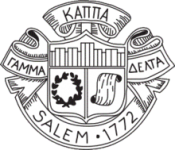Salem College
North Carolina
1772





It is not known when Salem College adopted white and gold as its school colors, but the college flower is the daisy, which displays the same colors.
Citations in the World Almanac (listed by cover date; color information is from the previous year): yellow/white (1923-1935)
The chevron was by far the most common heraldic division the Intercollegiate Bureau of Academic Costume (IBAC) employed to divide the two or three colors in an institution’s hood, but beginning in 1895 the “parti per chevron” was also used quite frequently. Here the two school colors were placed in the hood lining one above the other, with the division between them following the shape of a chevron. Later the Bureau began to use a per reversed chevron division and a division per bar on rare occasions. Confusingly, in IBAC lists from 1927 and 1948, a number of hoods were described as “[color] above [color]” or “[color] over [color]” which referred either to a hood lining divided per chevron, per reversed chevron, or per bar, and today it is not usually known which of these three patterns the IBAC intended to describe.
The Intercollegiate Bureau assigned Salem College a hood lined “lemon yellow above white” no later than 1927, according to an IBAC list from that period. Similar descriptions were used in 1948 and 1972 lists from the Bureau. “Lemon yellow” was a phrase the Intercollegiate Bureau of Academic Costume used to describe a bright yellow color, and yellow was heraldically synonymous with gold, Salem’s actual school color.
The division of the two colors is precisely defined in a list compiled by Kevin Sheard in Academic Heraldry in America (1962), which described the college’s hood lining as yellow over white, divided per chevron.